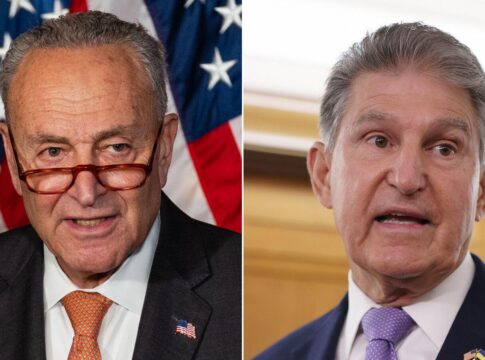US Congress Revives the $369 Billion Climate Change Bill
U.S. Senators Joe Manchin and Chuck Schumer unveiled a long-awaited reconciliation bill to invest $369 billion to fight climate change and advance clean energy programs.
The new U.S. bill is dubbed the “Inflation Reduction Act of 2022″. It would be the biggest and most aggressive investment ever taken by Congress for climate.
The bill is 725-page long with major provisions to cut down emissions of the U.S. by about 40% by 2030.
The deal came two weeks after Sen. Manchin said he would not support a bill with clean energy and tax provisions while inflation remains high.
But it appears that he kept the door open by reviving the climate bill once more after a year of pained negotiations.
If passed and signed into law, it would be a major victory for President Joe Biden’s climate agenda that he ran on in 2020. That agenda was attacked by the Supreme Court last June.
Taken as a whole, the bill would be a great win for clean energy tax credits as the centerpiece. The deal extends the current renewable credits. Beyond 2025, they will be technology neutral and be based on GHG emissions reductions.
Senate Finance Chair Ron Wyden said that:
“For the first time, the tax code is going to reward emissions reductions… and encourage the development of new clean energy technologies as soon as they come online.”
Lawmakers, environmentalists, and climate advocates who had been hammering Manchin for rejecting the climate measures were ecstatic at the surprise announcement.
The Inflation Reduction Act of 2022: Key Climate Provisions
The Act includes five key climate provisions with the following funding details:
Cutting Consumer Energy Costs. The bill will provide a range of incentives to consumers to relieve the high costs of energy and decrease utility bills. These include buying energy efficient appliances, clean vehicles, and rooftop solar. The specific funding includes:
$9 billion in consumer home energy rebate programs
$4,000 consumer tax credit to buy used-clean vehicles
Up to $7,500 tax credit to buy new clean vehicles
$1 billion grant program to make housing more energy efficient
Both tax credits would only be available to lower and middle income consumers.
Energy Security and Domestic Manufacturing. The climate change bill will support manufacturing cleaner energy products through historic investments. That includes ~$60 billion across the full supply chain of on-shore clean energy manufacturing and transportation technologies.
$30 billion production tax credits for manufacturing of solar panels, wind turbines, batteries, and critical minerals processing
$10 billion tax credit to build clean technology manufacturing facilities
Up to $20 billion in loans (with $2 billion in grants) to build new clean vehicle manufacturing facilities
$2 billion for National Labs to boost breakthrough energy research
These manufacturing incentives will help ease inflation by bringing down the cost of clean energy and clean vehicles. It will also relieve supply chain bottlenecks.
Decarbonizing the Economy.
Climate investments will cut emissions across all sectors of the economy. The primary sectors include electricity production, transportation, industrial manufacturing, buildings, and agriculture.
$30 billion tax credits (for states and electric utilities) for clean sources of electricity and energy storage
$6 billion grants and tax credits to reduce emissions from the largest industrial emitters (e.g. chemical, steel and cement plants)
$9 billion for the Fed government to buy American-made clean technologies
$27 billion clean energy technology accelerator to support deployment of technologies to reduce emissions
The climate change bill also includes unspecified funding for a program to reduce methane emissions from the production and distribution of natural gas. Methane emissions are more than 80x as potent as CO2 in warming the atmosphere.
Environmental Justice Investments. The climate deal includes ~$60 billion in environmental justice investments into disadvantaged communities. It will address the unequal effects of pollution on low-income communities and communities of color.
Agriculture, Forests, and Rural Communities. The funding will ensure that rural communities are at the forefront of climate solutions. Investments that will be made include:
Over $20 billion to support climate-smart agriculture practices
$5 billion in grants to support forests, forest conservation and urban tree planting
$2.6 billion in grants to conserve and restore coastal habitats
Tax credits and grants to support domestic production of biofuels
Huge Win for Clean Energy Transition
Obviously, the climate change bill puts clean energy at the forefront – from manufacturing clean energy products to buying clean vehicles and supporting clean electricity sources.
President Joe Biden said the tax credits and investments for clean energy projects in the deal will create thousands of new jobs and help lower energy costs. And so he urged the Senate to move on the legislation the soonest time possible.
President Biden has pledged to curb the country’s emissions by 50% to 52% by 2030 and reach net zero emissions by 2050. But without the bill, that goal won’t be possible as per the analysis of Rhodium Group. The president remarked that:
“This is the action the American people have been waiting for… This addresses the problems of today – high healthcare costs and overall inflation – as well as investments in our energy security for the future.”
The Senate is set to vote on the proposed climate change bill next week. Then it will go to the Democrat-dominant House of Representatives.
The post US Congress Revives the $369 Billion Climate Change Bill appeared first on Carbon Credits.


